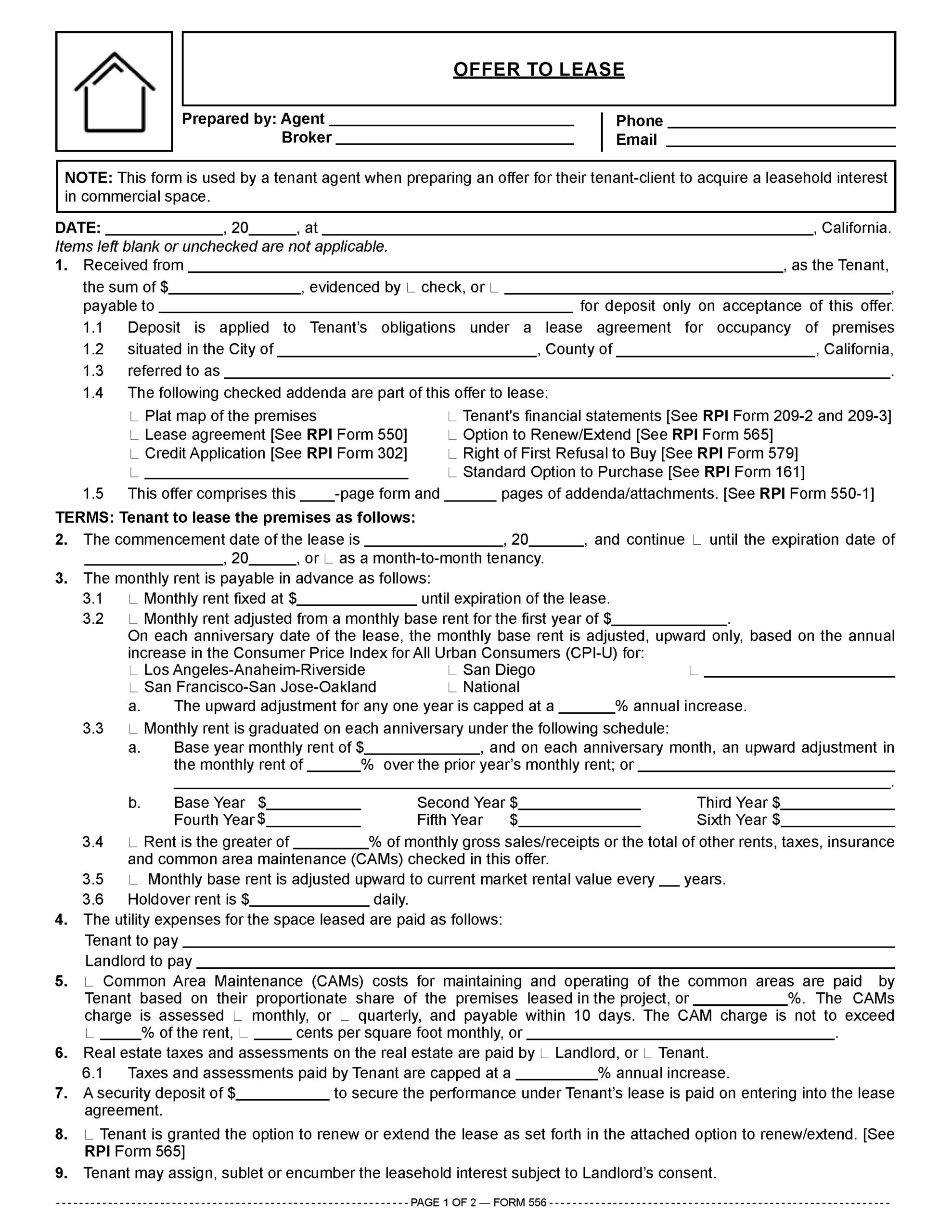This form is used by a tenant agent when preparing an offer for their tenant-client to acquire a leasehold interest in commercial space.
Understanding a tenant’s intentions for leased property
To efficiently negotiate a commercial lease agreement on behalf of a tenant, a leasing agent needs to possess a high level of knowledge and expertise regarding the terms of a lease. A leasing agent best determines a tenant’s intentions for leasing property by preparing:
- a tenant lease worksheet to assess the tenant’s space requirements, and, with financial statements, the financial condition of the tenant’s business [See RPI Form 555]; and
- an offer to lease and attached lease agreement to commit the tenant so an acceptance by the landlord will bring about an enforceable contract set by the terms of a lease agreement or a viable counteroffer. [See RPI Form 556]
With or without a written retainer agreement with a tenant, the leasing agent who undertakes the task of locating space for the tenant assumes agency obligations to act in the best interest of the tenant client.
However, without a written agreement, the leasing agent has no assurance their fee, when earned, will be paid. [Phillippe v. Shapell Industries, Inc. (1987) 43 C3d 1247]
Thus, the prudent leasing agent only undertakes the duty to represent a tenant when the tenant signs an exclusive authorization to locate space. [See RPI Form 111]
A leasing agent acting on behalf of a tenant needs to investigate and confirm why the tenant wants to move to understand their client’s needs. [See RPI e-book Real Estate Property Management Chapter 15]
By uncovering the precise reasons for moving, the tenant’s agent is better able to find a suitable new location and premises or negotiate a renewal or extension of the tenant’s current lease.
Contents of the offer to lease
An offer to lease needs to set forth all crucial elements negotiated to bring the landlord and tenant together in final leasing arrangements. [See RPI Form 556]
An offer to lease, like an offer to purchase, contains four primary sections:
- identification of the parties and premises;
- rental payment schedules and period of occupancy;
- property maintenance and terms of possession (use); and
- signatures of the parties.
A floor plan or common description of the premises is usually attached by a reference to it in the identification section.
The tenant is asked to include a good faith deposit. The check for the deposit needs to be made payable to a broker involved, not the landlord.
Upon receipt of the good faith deposit, the broker holds the deposit in a trust account as trust funds. When lease negotiations are unsuccessful, the broker returns the good faith deposit to the prospective tenant.
The section of the offer which sets forth the rental payment schedule is formatted as a checklist of various rental arrangements which may be selected by the tenant to structure their payment of rent, including:
- the duration/term of the initial leasing period;
- the monthly base rent for the first year;
- any rental adjustments during the leasing period for inflation and appreciation;
- responsibility for insurance policies, premium payment and payment of property taxes;
- the amount of the security deposit; and
- options to renew or extend the leasing period, or to buy the property.
It is good brokerage practice to reference and attach a copy of the proposed lease agreement form to the offer. The lease agreement includes boilerplate provisions covering:
- the responsibility for property operation and maintenance expenses [See RPI Form 552 §§5 and 6];
- the right to assign, sublet or encumber the lease [See RPI Form 552 §9];
- subordination/trust deed lender rights [See RPI Form 552 §17];
- default remedies [See RPI Form 552 §21]; and
- eminent domain. [See RPI Form 552 §19]
Some landlords, in response to an offer to lease, initially present prospective tenants with a fully prepared but unsigned lease agreement. This negotiation tactic works to the landlord’s advantage since it avoids any ambiguity over which lease document published by a given publisher is to be used. The participants then orally negotiate the final terms.
To better clarify negotiations, the broker writes up the offer to lease. Then, within the offer-counteroffer context, acceptable terms based on signed offers and counteroffers are developed. Expectations are properly reached, and negotiations are memorialized in writing to avoid later conjecture or discrepancies in memory.
The final section of the offer to lease is the signature section, where the landlord and tenant sign and agree to the terms stated in the offer.
By signing an offer to lease prepared by a broker, a prospective tenant initiates the negotiations in earnest on a property suitable for the tenant’s use. The landlord’s acceptance concludes the tenant’s search for space. [See RPI e-book Real Estate Property Management Chapter 16]
A leasing agent or prospective tenant uses the Offer to Lease form published by RPI when negotiating a rental or lease agreement for commercial space. It allows the tenant to make an offer on terms sufficiently complete to form a binding agreement on acceptance by the landlord. [See RPI Form 556]
Form navigation page published 11-2021.
Form last revised 2025.
Form-of-the-Week: Tenant Lease Worksheet and Offer to Lease – Forms 555 and 556
Article: Tenant profiles
Article: How new agents gain trust from commercial clients
Article: How to evaluate the location of a new commercial property
Article: How to create a commercial real estate marketing plan for 2018
FARM letter: Commercial tenant relocation













